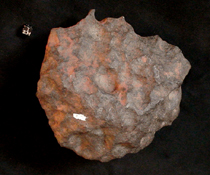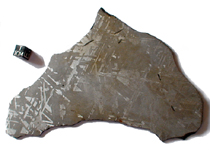Iron Meteorites
Iron meteorites are composed largely of nickel-iron metal, and most
contain only minor accessory minerals. These accessory minerals often
occur in rounded nodules that consist of the iron-sulfide troilite or
graphite, often surrounded by the iron-phosphide schreibersite and the
iron-carbide cohenite. Despite the fact that some iron meteorites contain
silicate inclusions, most have fundamentally the same superficial
appearance.
Presently, iron meteorites are classified under two established systems.
Just a few decades ago, iron meteorites were exclusively classified
according to the macroscopic structures revealed when their polished
surface was etched with nitric acid. Depending on these structures, they
were separated into three classes: octahedrites, hexahedrites, and
ataxites.
IIIAB Group
With about 233 members, group IIIAB is the best-represented class of
iron meteorites in our collections. Compared to the members of the IIIA
subgroup, which have mostly coarse octahedrite textures, the IIIB irons
usually display medium textures. Still, the members of both subgroups form
a continuous sequence in structural and elemental compositions that
suggests a common origin, probably representing different regions of an
asteroid's core. Group IIIAB contains several prominent members
representing some of the largest irons ever found. Just to name a few,
there are the giants of Cape York, Chupaderos, Morito, and Willamette -
have a look at our charts. Some
IIIAB members contain large nodules of troilite and graphite, but silicate
inclusions are rare. Despite this fact, recent research suggests a close
relationship exists between the IIIAB irons and the silicate-rich main
group pallasites, some of the most attractive stony-iron meteorites
known. Both groups probably formed on the same parent body, a
differentiated asteroid that was disrupted by a single impact event. The
IIIAB iron meteorites represent fragments of the core, while the
main-group pallasites are samples of the core/mantle boundary of this
common parent body.
|
Henbury
IIIAB
Year found: 1931
Country: Australia
TKW : 2 MT
|
|
|
 
|
|
|
|
Henbury-00
Complete oriented henbury, really pretty !
SOLD
Price
on request |
|
|
|
|
|
|
|
Henbury-01
Complete slice showing nice structure !
176 gr
875 $
|
|
|
|
  |
|
|
|
|
|
|
|